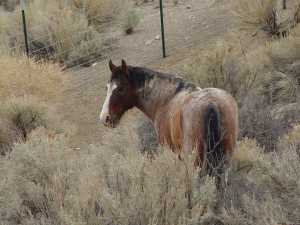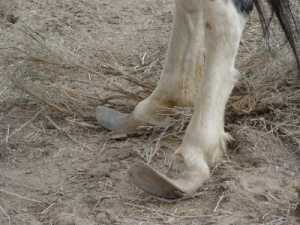KBR Horse Net
|
Rusty
|
|
A little background on Rusty
According to people in the area, Rusty was injured as a foal. He would hobble around trying to keep up with his band. He was noticed because he was often a quarter mile or more behind the group, calling out to them. He would eventually catch up, but would again be left behind when the band moved on. It is amazing that he wasn't taken down by predators. His injury not only impacted his mobility, but also his natural ability to keep his hooves worn down. They eventually got so bad that he could no longer sustain himself on the range. At the end of February, 2004, the LRTC Wild Horse Mentors received an unusual call for help from Carol Valles of Stagecoach, NV who reported that she had an injured Virginia Range mustang that she had rescued. He had apparently suffered an injury to his hip that had resulted in deformed hind hooves which prevented him from successfully competing with the other horses on the range. A year earlier the horse had "followed her home" when she was out on a ride, starved and hopping on three legs. He spent the winter in her yard where she was given permission to give him food and water until he was healthy enough to return to the range. On a ride in the fall of 2003 fall she again found "Rusty," this time in such a debilitated condition that he couldn't move. Each day she packed up hay and water to him until he was strong enough to follow her home.
She got permission from the state to again rehabilitate Rusty. (People aren't allowed to feed or hold wild horses without approval.) He again regained decent weight. | |
|
By this time his hind feet had gotten so bad that he clearly was not going to make it in the wild. If Carol was willing to gentle the horse and address his twisted hooves, the state would give her permission to hold him. The only problem was that Carol was moving to another ranch and that's where we first got involved.
Carol needed to get Rusty in a trailer and moved to a small fenced pasture with a natural spring. Carol had previously corralled Rusty for a veterinarian to examine him. While he was somewhat used to Carol, he was still frightened of other humans. He couldn't jump but he climbed over the corral panels as would a dog. Loading him into a trailer could be challenging. |
Rusty's twisted and abscessed hind feet
|
|
Problem #1 - Moving Rusty
Shirley Allen and I brought out the LRTC emergency corral and loading chute. The corral was basically a hexagon pen made of 16 ft long panels. (The hexagonal shape avoided 90 degree corners that might cause a horse to want to jump or crash the fence.) At one end of the corral was a gate that led into a 16 foot long chute made of two 16 foot long panels set on either side of the gate. Carol baited the corral with hay and water and the next morning we found Rusty the mustang inside. We backed the stock trailer to the chute and started working with Rusty to get him into the loading chute. We had a couple of issues to consider. First Rusty was known to be volatile around strangers and had climbed out of at least one pipe corral before. While our layout might discourage a horse from jumping, there was nothing to prevent him from crawling over and out. Secondly Rusty's hind feet looked like Aladdin's shoes. The long curled tips could get hung up on the trailer if we tried to rush him inside. We decided to start out slow and easy using pressure and release and see if he would respond. Before long Rusty progressed from trying to run over me to moving lightly to the pressure of a flag. The secret to success was to let him constantly win. I would ask for small steps in the desired direction and immediately reward him with a release of pressure when he responded. Within a few minutes he was walking quietly in and out of the chute on cue. We did have a little problem in the chute. No matter what we tried, Rusty simply wouldn't face up to the trailer and he could be easily agitated so we didn't dare turn up the volume too high. We had to take what Rusty presented to us and "think outside the box." Shirley and I shrank the end of the chute that was distant from the trailer to make a triangle. The trailer made the base of the triangle. That configuration put Rusty's nose at the point of the triangle. I started rubbing him with a piece of 3/4" PVC pipe I found nearby and then with some ropes. In less than an hour he had settled to the point we could put our hands on him and in less than two hours I could handle his head, put my fingers in his mouth and halter him repeatedly without a fight. There were three keys to getting the halter on without a fight. First, as soon as Rusty would tolerate contact, we put people on both sides of him rubbing him quietly. When he could deal with that, we did a lot of facial work, similar to what Frank Bell demonstrates, getting our hands over his eyes, around his poll, under his jaw, fingers in his mouth and nostrils massaged. He seemed mesmerized by all of that and his head dropped about a foot. Finally, before trying the halter, I passed a Tellington Jones "neck loop" over him several times and worked on gently giving to pressure on the neck and nose with the loop. All that were handy were web halters and we had to find one that would fit Rusty. I fashioned a quick halter out of a length of lead rope and asked Rusty to give to pressure. He soon figured this out and we could easily control his head while we tried different halters and found one that fit fairly well. Once haltered, I attached a lead line and it was time for Carol to practice leading the Rusty. When Rusty reached the point that he would take a couple of steps in response to a light "ask" (the lead gripped only by a little finger) we straightened out the chute and led him toward the trailer. Walking toward the trailer was another issue. We would ask and Shirley would apply a wee bit of pressure from behind with a flag if he was "stuck." We didn't want to rush him in. He needed time to think and make sensible decisions. The first time Rusty got two feet inside, the people outside by the chute got a bit too animated and he reacted to the pressure and backed out. He then tried to pull away a couple of times and we had to restrain him, but we immediately gave him slack when he faced back toward the trailer. When he regained his focus we gave him some nice rubs and moved him again toward the trailer, one step at a time. With one foot in, Rusty looked all around the inside of the trailer and snuffled some bits of alfalfa that were on the floor. With another ask two feet were in. Carol's boyfriend, Adam, and I were both inside the trailer. I walked up to Rusty and gave him some nice rubs, then we both walked toward the front of the trailer to present a clear image of a withdrawal of presence or pressure while Shirley rustled the flag. Rusty stepped in like a pro. Shirley quietly closed the rear gate while Adam and I stroked Rusty. When we were sure that he was OK in the trailer (standing quietly and curiously looking out the vent slats) I unhooked the lead, and we both walked quietly by him and Shirley let us out. Two miles of bad road would be an understatement. It was low range and first gear much of the way to keep the trailer from pitching Rusty all about. When we got to our destination we were unable to back the stock trailer up to pen where Rusty needed to be placed. I parked as close as I could, then studied Rusty in the trailer. Rusty was scared and shaking but he was quiet. Shirley opened the trailer gate so I could slip inside. I established contact with Rusty and rubbed him to remind him that we meant him no harm. I hooked on the lead rope, Shirley opened the rear gate and we stepped out. Earlier in the trap corral when we were teaching him to lead, Rusty had pulled away a couple of times during his leading lessons. But each time he would stop a few feet away and we could pick up the lead. Based on that behavior, our strategy here was simple. We would set up a human screen and if he did pull loose everyone would stay quiet until he settled down and we'd simply walk over and pick up the lead. Rusty got a little stimulated stepping out of the trailer but he wasn't out of control. A minute or two later we did have some disagreement when he wanted to head off to the right and we needed to get to a corral gate on our left, but our human screen provided just enough deterrent that he followed willingly once he saw the opening in the fence that I was trying to get him through. Inside the corral I stopped, rubbed him a little, then removed the halter. Naturally he turned away to explore the area. After putting the halter away I was able to quietly approach Rusty, touch his nose, then rub his neck. The trailer ordeal didn't undermine our primary objective, getting him tame enough to work on his feet. In fact since everyone was calm and methodical, he was far more tame after being trailered than before, which is a good thing since we had to gentle him in an area larger than an acre.
Continue to Gentling Rusty in a Large EnclosurePress "Back" to return to the page that brought you hereReturn to Case Study SectionReturn to Training SectionReturn to Wild Horse MentorsReturn to KBR World of Wild Horses and BurrosGo To
|

